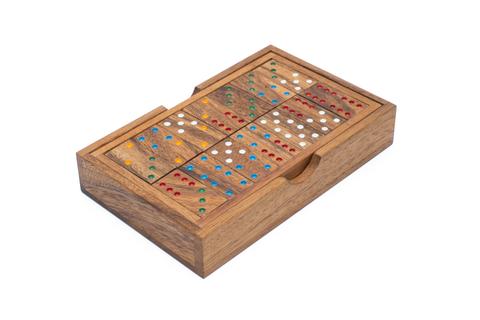What are Dominoes?
Most of you will probably have heard of the dominoes before (everyone’s it is after all everyone’s favorite table game along with Tic Tac Toe). The game of dominoes has existed for hundreds of years, having been mentioned in documents from 13th century China.
The game is played with a set of rectangular tiles or dominoes. These will be plain or decorated on one face, and on the other face, they will have two sets of spots, or ‘pips’. The length of a tile is normally double its width, and they are made thick enough to stand on their side for those who enjoy making a pattern and watching the dominoes fall in succession.
How Many Dominoes in a set?
A set, or deck, typically consists of 28 dominoes. The pips on the tiles will represent the 21 pairs of numbers which can be thrown with a pair of standard dice, plus seven more including a zero or blank. Larger sets are made, featuring more pips, to enable more players to take part, but we will focus on the standard 28-tile dominoes set here.
How do you Play Dominoes?
Players place tiles on the table in turn, matching one face of the domino with an open face of one that has already been played. The objective of dominoes is generally to score the most points, by putting your tiles down in the most advantageous way, although some versions are won by the first player to put down all of their tiles. The game can be surprisingly strategic, and, whilst luck does play a part, it is very difficult to beat a skilled player with any consistency.
Dominoes Game Rules – Straight Dominoes
Straight dominoes can be played by two to four players.
Tiles must be mixed up before the players can draw their hand. This is done by a process of shuffling, whereby the tiles are placed face down on a flat surface and one player moves them around randomly without maintaining contact with any specific tiles.
The players then draw one domino each, to determine who plays first.
The player drawing the highest double goes first, or, if no double is drawn, the player with the highest-scoring domino.
Each player now draws a hand of seven tiles, with the player who did the shuffling drawing last.
If there are tiles left over, these remain face down to be drawn by players who are unable to put anything down on their turn.
The first player begins by laying their chosen tile face-up in the middle of the table.
The next player must match one end of one of his dominoes to part of the first tile.
In some versions, for this domino only, tiles are allowed to be joined to all four sides, creating four open lines to which new dominoes can be added.
From this point, players can add their tiles to whichever line they choose. If a double is played, this is laid perpendicular to the line, and the pips on both ends are counted.
If a player does not have any dominoes which can be played, they must draw another from the unused tiles.
Dominoes Scoring
Points are scored by a player in straight dominoes if the total number of pips on the exposed ends of the dominoes at either end of the line is divisible by five, in which case that number is scored.
Other versions allow only scores which are divisible by three or make no restriction. If a player is able to play their last domino, then, in addition to the points which would otherwise have accrued, they score the total of the number of pips on the tiles which remain in each player’s hand.
Games are often played until one competitor reaches a preset score, typically 250. Some types of the game simply award victory to the first player to play all of their tiles. It can happen that no player can play a tile, in which case the game is said to be ‘blocked’. The winner of this game is the player with the smallest number of pips on their remaining tiles, and they will score the total number of pips remaining on their opponent’s tiles.
Dominoes Strategy
The best strategy to use will depend upon the form of the game and the scoring system. Nonetheless, under any system, a player will want to ensure that they are not left with tiles which cannot be played, ensure that they are not left with particular tiles which have a large number of pips which could count against them at the end.
Tips
It is particularly helpful to play doubles early, as these have the same number of pips at each end and there will fewer opportunities to play them. The second highest priority will be the biggest scoring tiles, due to the penalty for being left with these.
Retaining a wide range of numbers on your remaining tiles is a good plan, as this means you are more likely to be able to play a tile whatever your opponent does.
Equally, a good strategist keeps careful note of when their opponent passes, so that they are aware of the numbers that their adversary is short of.
Finally, as the game progresses, if you analyse the tiles played and those you have, in conjunction with your opponent’s passes, you should be able to work out which tiles they have, enabling you to block them.

